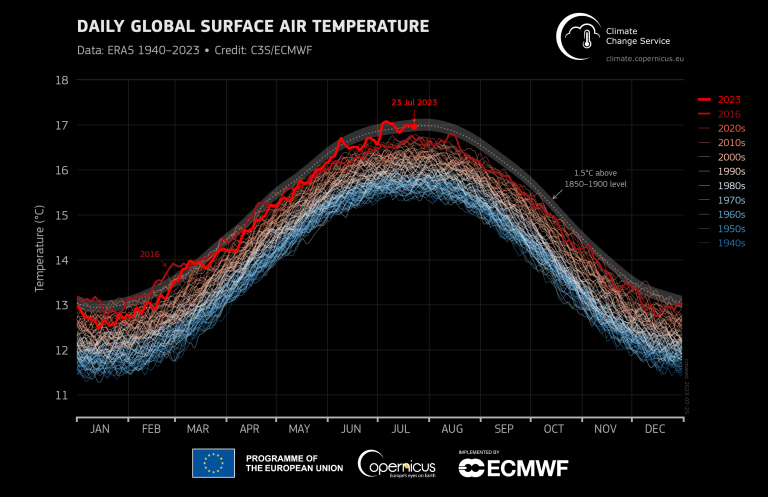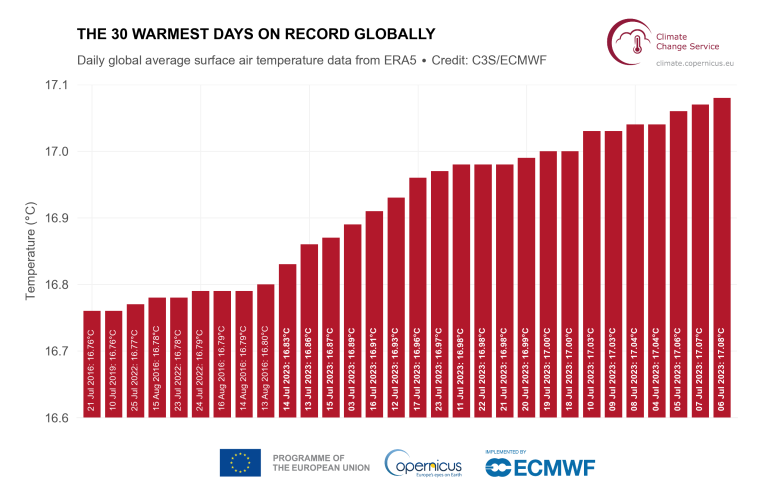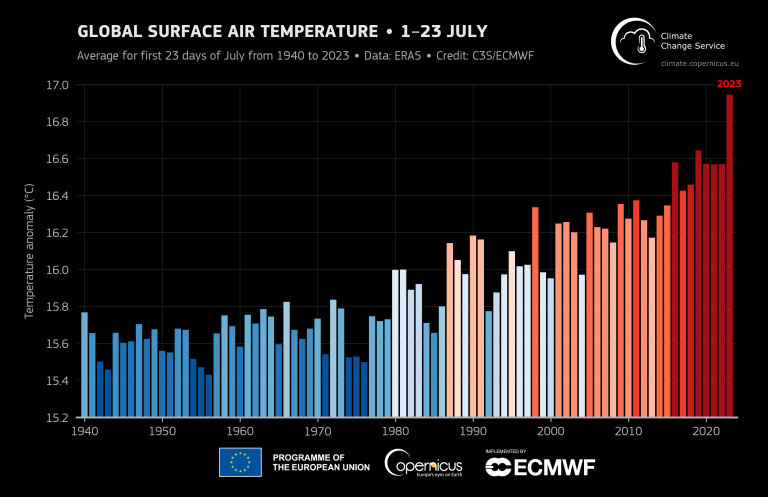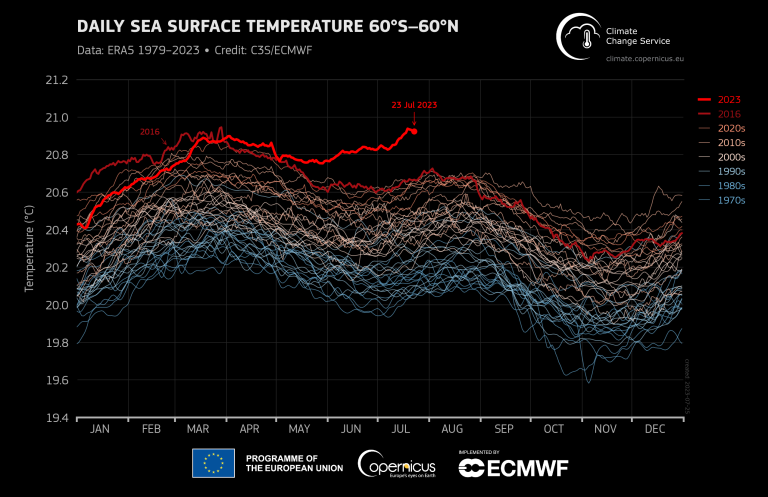July 2023 is set to be the hottest month on record
Bonn and Geneva (Copernicus and WMO) - According to ERA5 data from the EU-funded Copernicus Climate Change Service (C3S), the first three weeks of July have been the warmest three-week period on record and the month is on track to be the hottest July and the hottest month on record. These temperatures have been related to heatwaves in large parts of North America, Asia and Europe, which along with wildfires in countries including Canada and Greece, have had major impacts on people’s health, the environment and economies.
- Published in partnership with:
- European Union ,
- Copernicus ,
- European Centre for Medium-Range Weather Forecasts (ECMWF) ,
- Copernicus Climate Change Service (C3S) ,
- World Meteorological Organization (WMO)

« We don’t have to wait for the end of the month to know this. Short of a mini-Ice Age over the next days, July 2023 will shatter records across the board, » said United Nations Secretary-General António Guterres.
« According to the data released today, July has already seen the hottest three-week period ever recorded; the three hottest days on record; and the highest-ever ocean temperatures for this time of year, » Mr Guterres told journalists at UN headquarters in New York.
« For vast parts of North America, Asia, Africa and Europe – it is a cruel summer. For the entire planet, it is a disaster. And for scientists, it is unequivocal – humans are to blame. All this is entirely consistent with predictions and repeated warnings. The only surprise is the speed of the change, » said Mr Guterres.
On July 6, the daily average global mean surface air temperature surpassed the record set in August 2016, making it the hottest day on record, with July 5 and July 7 shortly behind. The first three weeks of July have been the warmest three-week period on record. Global mean temperature temporarily exceeded the 1.5° Celsius threshold above preindustrial level during the first and third week of the month (within observational error). Since May, the global average sea surface temperature* has been well above previously observed values for the time of the year; contributing to the exceptionally warm July.It is extremely likely that July 2023 will be the hottest July and also the hottest month on record, following on from the hottest June on record. According to ERA5 data the previous hottest month on record was July 2019. Complete ERA5 data for July will be available and published by C3S in their upcoming monthly bulletin on August 8.
It is extremely likely that July 2023 will be the hottest July and also the hottest month on record, following on from the hottest June on record. According to ERA5 data the previous hottest July and month on record was July 2019. Complete ERA5 data for July will be available and published by C3S in their upcoming monthly bulletin on August 8.
WMO consolidates data from C3S and five other international datasets for its climate monitoring activities and its State of the Climate reports.

Carlo Buontempo, Director of the Copernicus Climate Change Service (C3S) at ECMWF, comments: “Record-breaking temperatures are part of the trend of drastic increases in global temperatures. Anthropogenic emissions are ultimately the main driver of these rising temperatures”. He added “July’s record is unlikely to remain isolated this year, C3S’ seasonal forecasts indicate that over land areas temperatures are likely to be well above average, exceeding the 80th percentile of climatology for the time of year”.
“The extreme weather which has affected many millions of people in July is unfortunately the harsh reality of climate change and a foretaste of the future,” said World Meteorological Organization’s Secretary-General Prof. Petteri Taalas. “The need to reduce greenhouse gas emissions is more urgent than ever before. Climate action is not a luxury but a must.”
WMO predicts that there is a 98% likelihood that at least one of the next five years will be the warmest on record and a 66% chance of temporarily exceeding 1.5°C above the 1850-1900 average for at least one of the five years.
This does not mean that we will permanently exceed the 1.5°C level specified in the Paris Agreement which refers to long-term warming over many years.
1. Highest daily global mean surface air temperatures on record
According to the ERA5 dataset, the global mean surface air temperature reached its highest daily value (17.08°C) on 6th July 2023. This value was within 0.01°C of the values recorded on 5th and 7th July. As shown in the chart above, all days since 3rd July have been hotter than the previous record of 16.80°C from 13th August 2016.

2. Highest monthly global mean surface air temperature on record
According to the ERA5 dataset, the global mean surface air temperature averaged for the first 23 days of July 2023 was 16.95°C. This is well above the 16.63°C recorded for the full month of July 2019, which is currently the warmest July and warmest month on record. At this stage, it is virtually certain that the full monthly average temperature for July 2023 will exceed that of July 2019 by a significant margin, making July 2023 the warmest July and warmest month on record.

3. Well above-average global sea surface temperatures
Daily sea surface temperatures (SSTs) averaged over the global extrapolar oceans (60°S–60°N) have stayed at record values for the time of year since April 2023. Most notably, since about mid-May, global SSTs have risen to unprecedented levels for the time of year. According to ERA5 data, on 19th July, the daily SST value reached 20.94°C, only 0.01°C shy of the highest value recorded for 29th March 2016 (20.95°C).

4. New national temperature records
National meteorological and hydrological services have reported a number of daily and station temperature records and are responsible for verifying any new national temperature records. Thus, China set a new national temperature record of 52.2°C on 16 July (Turpan city in China's Xinjiang province), according to the China Meteorological Administration. WMO’s provisional State of the Global Climate 2023 report, which will be presented to COP28 in December, will incorporate details of new national temperature records.
The temperature record for continental Europe of 48.8°C (119.8°F) measured in Sicily on 11 August 2021 was not broken during the July heatwaves, according to provisional information.
Temperature records in the United States of America are maintained by the US National Oceanic and Atmospheric Administration’s National Centers for Environmental Information.
Notes to Editors
C3S, implemented by the European Centre for Medium-Range Weather Forecasts (ECMWF) on behalf of the European Commission, routinely monitors climate and has also been closely following recent development of global air and sea surface temperatures.
For further information on the high temperatures in early July, you can read this article, once the embargo is lifted.
Additional graphics and press resources on this topic could be found here.
You can find C3S seasonal forecast here.
Answers to frequently asked questions regarding temperature monitoring can be found here.
The World Meteorological Organization (WMO) is a specialized agency of the United Nations responsible for promoting international cooperation in atmospheric science and meteorology.
WMO monitors weather, climate, and water resources and provides support to its Members in forecasting and disaster mitigation. The organization is committed to advancing scientific knowledge and improving public safety and well-being through its work.
For further information, please contact:
- Clare Nullis WMO media officer cnullis@wmo.int +41 79 709 13 97

